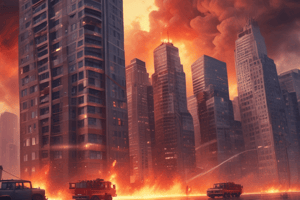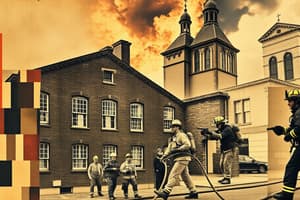Podcast
Questions and Answers
What is the recommended size for a collapse zone around a structure?
What is the recommended size for a collapse zone around a structure?
- The height of the structure minus an allowance for debris scatter
- The height of the structure only
- The height of the structure plus an allowance for debris scatter (correct)
- The height of the structure multiplied by two
What is the most important consideration for the IC?
What is the most important consideration for the IC?
- Effectiveness of the operation
- Safety (correct)
- Accountability
- Adherence to SOPs
What is the acceptable method of organizing an incident?
What is the acceptable method of organizing an incident?
- NFPA
- OSHA
- FEMA
- NIMS (correct)
What is required by regulations and standards?
What is required by regulations and standards?
What should be evaluated by the IC regarding hazard control?
What should be evaluated by the IC regarding hazard control?
What determines whether the operation will be offensive or defensive?
What determines whether the operation will be offensive or defensive?
What can increase weight and affect building stability?
What can increase weight and affect building stability?
What should be stored no closer than 24 inches from a wall?
What should be stored no closer than 24 inches from a wall?
What is superior to all other building types in regard to structural stability under fire conditions?
What is superior to all other building types in regard to structural stability under fire conditions?
What is the recommended method of going to work at a fire scene?
What is the recommended method of going to work at a fire scene?
What can injure and kill during a collapse?
What can injure and kill during a collapse?
What should fire department personnel know about tools and equipment used on the fire ground?
What should fire department personnel know about tools and equipment used on the fire ground?
Study Notes
- Operational status factors apply when an IC arrives after first-due companies have begun operations.
- SOPs provide a standard method of going to work at a fire scene.
- The IC must evaluate the safety and effectiveness of the standard operation.
- Safety should be the IC's most important consideration.
- The effectiveness of the operation must constantly be evaluated.
- Adherence to SOPs is evaluated when command is transferred.
- Hazard control zones and perimeters should be evaluated by the IC.
- Accountability is important and a formal system is required.
- A rapid intervention crew is required by regulations and standards.
- NIMS is the acceptable method of organizing an incident.
- A thorough risk-versus-benefit analysis determines whether the operation will be offensive or defensive.
- Collapse can be catastrophic, and many partial collapses can injure and kill.
- A collapse zone encompassing the height of the structure plus an allowance for debris scatter is recommended.
- Fire department personnel should know the strengths and limitations of tools and equipment used on the fire ground.
- Building should be classified by construction type.
- Code requirements change, and the fire-resistive building is superior to all other building types in regard to structural stability under fire conditions.
- The roof covering can be important, particularly if it is combustible.
- A building in poor repair or one that has been previously damaged presents an extra hazard for fire fighters.
- Live and dead loads are important factors in determining the overall load on a structure.
- Fire suppression water load is an important factor to consider during fire operations.
- Prolonged water streams can affect building integrity
- Most buildings hold only a small percentage of water from master streams
- It's difficult to determine how much water is being retained in any area of the building
- Preplan information can be helpful in determining water retention
- Storing water-absorbent materials can increase weight and affect building stability
- Normal floor loads should be reduced when storing water-absorbent commodities
- Water-absorbent materials should be stored no closer than 24 in. from a wall
- Damaged buildings can create dams that retard water runoff
- Structural failure can occur due to the weight of water during pumping
- Runoff should be observed during firefighting operations.
Studying That Suits You
Use AI to generate personalized quizzes and flashcards to suit your learning preferences.
Description
Test your knowledge of essential firefighting principles and practices with this quiz! From operational status factors to building construction types, this quiz covers a wide range of topics that are crucial for firefighters to understand. Learn about safety considerations, hazard control zones, collapse zones, and much more. Whether you're an experienced firefighter or just starting out, this quiz is a great way to test your knowledge and improve your skills. So put on your thinking cap and get ready to tackle some tough questions!



